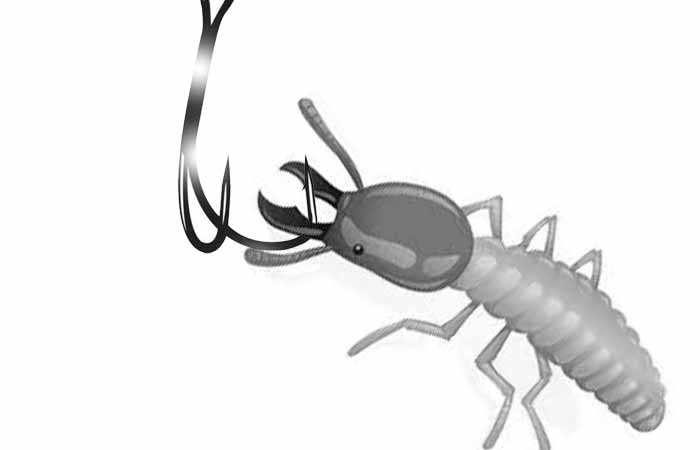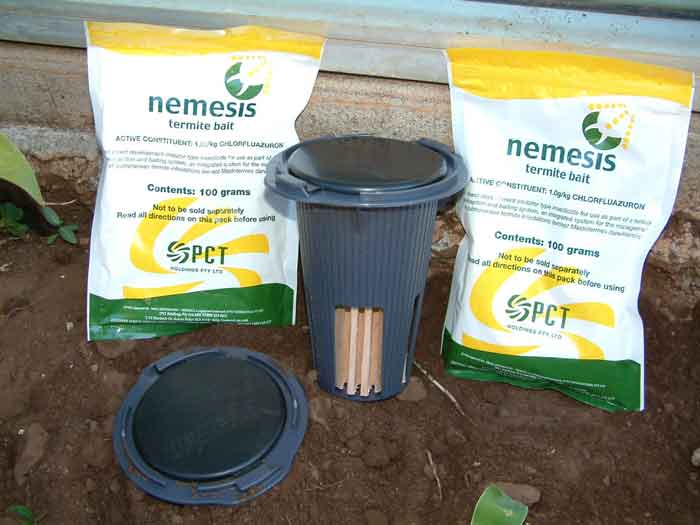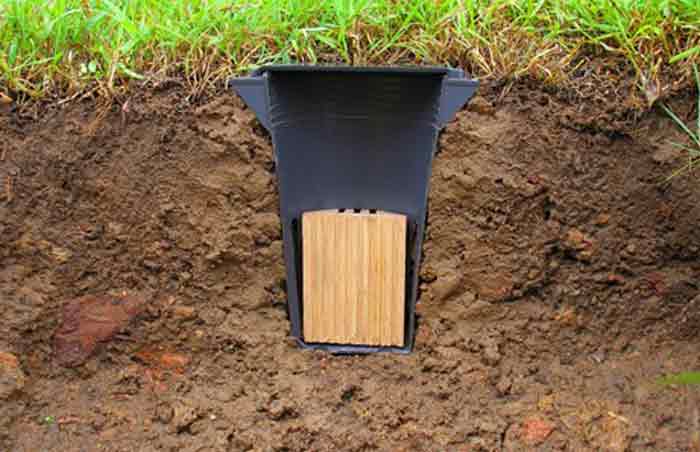Termites are not only destructive but they can also be a nuisance when they are all over your property. In attempt to bring termite colonies to an end, traps and bait stations/systems and have been used as one of the ways of eliminating these insects. This article discusses more about how these control mechanisms work and the different types .
Table of Contents
What are Termite Baits and how do they work?
What they are
Termite baits are stations structured in such a way that they use the termites’ natural behavior to attract them and kill them.
These baits are simply defined as feeding stations which are made of wood material and an additional toxic substance.
Basically, to make a good termite bait, you require paper, cardboard (or an alternative termite food), and any substance which is lethal to termites but acts slowly.
When making your termite bait, you must remember that you are in a competition to win termites from going to other sources of food like structural wood, stumps, and tree roots.
Termite baits in most cases target subterranean termites since they are the ones which live underground.
Termite baits are about 30 cm in length and they resemble cylindrical tubing which is vented. Each termite trap has a cap which is lockable.
There are tiny ventilation grills on the top part. Termite baits are placed deep into the ground. However, the top of the trap is left to be in level with the soil.
There are three main reasons as to why the baits are placed this way.
Firstly, it is to avoid obstructions when you go about your daily activities in the garden.
Secondly, this is so that they are not exposed since they are supposed to serve as a trap and finally, they are placed this way since most termites are found underground or crawling on the soil.
You can either have your bait station underground or you can just set up the bait stations next to mud tubes off active termites. Usually, you do not place treated wood on the baits set underground not unless you have detected some termite activity in the station.
How they work/how are they used?
Termite baiting systems work effectively. This is because, they take into account the three main steps followed in most processes which aim at killing termites.
Below are the reasons why bait systems work;
They attract termites
The first thing the baiting stations do is to attract termites. This is achieved by ensuring Tasmanian oak timber forms part of the bait. This is one of the timbers considered by termites to be their favorite food.
Another attractant used in making the baiting stations is Focus. Focus has the ability to attract termites when they are up to three meters away.
Hexaflumuron is made part of the baiting stations
This is an insect regulator which inhibits normal growth of termites. When exposed to it, they can no longer shed their exoskeleton.
The exoskeleton of termites is totally destroyed as soon as they are exposed to hexaflumuron. This growth inhibitor also contains cellulose which attracts termites to the bait.
Hexaflumuron is chosen since it acts slowly and does not cause instant death of the termites. Remember, your intention is to ensure it is transferred to the rest of the colony.
If you were to use a substance which causes instant death, the termites would lie dead on or next to the termite bait giving a signal to the other termites that there is danger and they should stay far away from the bait.
In summary, there are two main things that the bait stations achieve due hexaflumuron;
- It makes it hard for the termites to chew timber by softening their mandibles.
- It makes their exoskeleton very weak and soft. This way, the termites cannot undergo the growth process. This not only terminates the current termites but it also puts an end to their future since they cannot reproduce.
Baiting station eliminate the entire colony
Even though not all termites are attracted to the baits, most of them do. When the termites that have been trapped escape back to their colony, they spread the poison. This leads to eventual death of all members of the colony.
Termite Bait traps- do it yourself (DIY)
You can make bait traps at home without involving a professional. The only thing you must remember when using homemade bait stations is that they may not deliver 100% excellence in eliminating termites when used alone.
No matter the bait station you make, it must be a non-repellant since the idea behind termite trap is to attract termites.
Below are some of the easy to make termite bait traps;
A cardboard station
This is the simplest baiting method which involves incurrence of very small costs.
All you will need here is to take a cardboard and place it in areas which are suspected to be infested with termites. This cardboard serves both as a monitoring tool and as a way of fighting termites.
You are advised to keep on checking the cardboard regularly so that you do not give time for the termites to come and leave. When you realize a high number of termites on the cardboard, you are supposed to immediately burn the cardboard so that all the termites on it die.
Borax termite bait station
There are plenty of ways in which borax bait stations can be made. The simplest of them all involves use of borax and a baseboard.
After buying borax from your nearest store, you are required to place it on the baseboard and then locate the place where you have noticed a termite infestation.
Borax is poisonous and termites exposed to it spread it to the rest of the colony members causing death of the entire colony.
A slightly complicated borax bait station is one which involves use of borax, wood, shovel and polystyrene foam. The wood treated using this ingredient is placed in the area where the termites have been spotted.
Termites get infected with this foam and this is the reason for their death. They however do not die immediately and this allows for the termites to take the poison to the rest of the colony. When you use this bait, keep children and pets away.
Boric acid bait station
To make boric acid bait stations, you will need a number of things; sugar, spoon, cellulose material such as a cardboard, and a bowl.
Procedure
- Add the sugar and boric acid into the bowl in equal ratios.
- Using the spoon, stir well to ensure you make a consistent mixture.
- Pour the mixture on the cellulose material (cardboard) evenly.
- Place the cardboard in the location which is infested with termites. You are always advised to ensure that children and pets stay away from the place where you place your cardboard.
Spectracide Terminate bait system
This is a termite bait system which has sulfluramid as the active ingredient. This ingredient hinders the termite’s body system from converting food to energy.
The termites require energy to go on their activities. For instance, the worker termites require energy to go get food for the colony. If they do not have the energy to do that, the whole colony will starve to death.
Just like most of the termite baiting stations, the active ingredient in spectracide is a slow acting chemical giving time for spread of the poison to numerous termites.
Super way termite bait stations
This bait station is easy to install and you do not need to call a professional to assist you in any way.
Once you purchase it from the nearest store, you are supposed to install it in the location where you have spotted the termites.
Orange oil bait
Spraying orange oil on a cardboard then placing the cardboard on the area infested with termites is another easy way to trap and kill termites.
Termite Bait Stations/Systems Reviews
Nemesis termite monitor bait system
This bait system works by stopping the chitin rebuilding function of the termites’ body. This as a result causes the termite to die. The system is made using special wooden cartridges which contain poison (chlorfluazuron).
Some of advantages of this baiting system over other systems is that; it has low toxic levels making it safe for use around people, it is easy to make any replacements to the baiting systems since all you will need is replace the wooden cartridges with new ones, and it effectively defends your house since the termites focus on the baits.
The shortcomings of this baiting system are that; it is slightly more expensive than the other baiting systems, it may require you to involve a professional, and it requires you to do inspection regularly.
Green termite bait systems
This bait system is also very effective and it is usually placed underground. When termites go on searching for food, they will come across the green termite bait and stop by.
With this system, you are in position to see exactly what is going on underground as it is structured in such a manner that it provides a window.
As soon as you see the termites in the bait system, you then add a small amount of termiticide which is then carried by these termites to the rest of the colony.
Based on information collected from thousands of homes, this baiting system leads to more than 99% success in killing of the termites.[1]
Sentricon bait system
Created by Dow AgroScience, sentricon bait system is ranked among the most effective and most widely used termite bait systems. This is due to its excellence in performing the three major roles pf a baiting system which are;
- Monitoring
- Bait deliver
- Continued monitoring
The sentricon baiting system contains noviflumuron which is a slow acting chemical.
This explains why, when termites are exposed to this bait, they stop growing and ultimately die.
Following its success in termite elimination, hundreds of thousands of baiting stations baited using sentricon have been set up.[2]
Hexaflumuron termite bait
This is a termite bait system made using hexaflumuron which prevents the termite from shedding its exoskeleton and hence bringing an end to its growth. The most common termite bait containing hexaflumuron is shatter termite bait.
When the termites fed on the shatter termite bait, it takes about four weeks before the entire colony is brought to an end.
This termite bait cannot be used since the termites that have fed on the bait leave some pheromones which prevent the other termites from feeding on the bait station.
Spectracide Terminate
This is a do it yourself baiting system which has been found to be very effective in killing termites.
Hexaflumuron is the active ingredient in spectracide terminate and as earlier discussed in the article, it hinders further growth of termites.
This bait contains cellulose which contains sulfluramid. This bait system has been offered in the market since the early 90’s and millions of people continue to buy today following its effectiveness. Subterranean termites are the ones that are mostly trapped using this baiting system.
Once they have eaten most of the stake making up the system, a spring loaded flag which is orange in color pops up as indicator that there is need for replacement of the bait.
Terro termite Killer
This termite killer is made up of very effective insecticides. It consists of water, cypermethrin (a substance which affects the termites’ nerve action), tetramethrin (causes nerve action on crawling termites), piperonyl butoxide (potentiates the effects of using tetramethrin), and some aroma additives.
There are several benefits that come with use of terro termite killer to eliminate termites. Some of the benefits are discussed below;
- First of all, it comes in different form such as sprays, jells, powders, traps, crayons, ointments, and concentrates. You have the chance to choose the form which will be most applicable for you.
- That aside, terro termite killer has long lasting effect. Upon application, its effects can go on for several weeks.
- It kills termites over a wide area in just a few hours.
The major disadvantage of using this method of termite elimination is that, if you choose sprays, they may cause respiratory problems to you. This is because some of the insecticides used are harmful to human health.
Termite Bait Stations vs Liquid Treatment
Discussions on which between termite bait stations and liquid treatments is better suggest that liquid treatments are the best.
Although the initial cost of setting up a termite baiting station is little, the amount of money you will spend repairing and maintaining the bait station in the long run may even exceed your budget.
On the other hand, trimedor barrier will applied once and it kills the termites without requiring further inspection and maintenance.
This means that, once you have applied the liquid treatments, you simply sit back and watch it kill all the termites.
Looking at the effectiveness, bait station are not 100% effective and they require back up of other ways of eliminating termites.
Unlike most of the baiting systems, liquid treatments are very close to 100% success in eliminating termites.
Although the initial cost of applying the liquid treatments is high, you will realize that they are more economical and efficient in the long run.
Further Reading
- Subterranean Termites Swarmers Treatment Cost, Damages & Pictures
- Flying Termites with Wings (Swarmers) Pictures & How to get Rid
- Termite Droppings-Drywood, what they look like, Health Risks, Clean vs Sawdust
- Formosan Termites Pictures, Signs Treatment & Damage
- How to Get Rid, Kill Termites + Treatment Cost
- What Causes & Attracts Termites?
- Do Termites Bite Humans? Pictures & Remedies
- Flying Ants vs Termites-Differences & Similarities
- Termite Inspection Cost, Procedure, how long it takes & Training
- Termite Colony-Queen, Soldier, Worker & King
- Drywood Termites Treatment Cost, Get rid & Damage
- Termite Bond Cost, Benefits
- Termite Baits, Stations & DIY Traps
- Dampwood termites Pictures, Damage & Treatment
- Termite Tenting & Fumigation- Cost, Preparation, Safety & Cleaning After
- Termite Barriers (Shields): Types, Cost, how they Work & Products
- Termites Damage, Pictures, Repair Cost, Ceiling, Floors, Wood & Fix
- Best Termite Sprays-Orange Oil (DIY), Boric Acid & Spectracide Reviews
- Termites Life Cycle & Span-Eggs, Larvae, Baby & Adults
- How to Prevent Termites-Tips to Protect your Home
- Signs of Termites Infestation-How do you know if have you them?
- What do Termites look like? Pictures, Size, Color & Look-alikes
- Termites: Where From, Habitat, Eat, Noise, Types +more!
References
[1] https://www.greenpest.com.au/the_green_termite_bait_system.html
[2] https://www.uky.edu/Ag/Entomology/entfacts/struct/ef644.htm


